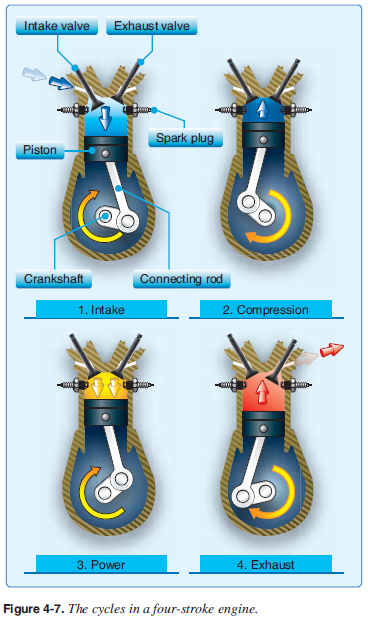
 |
|
||
| CHAPTER 4. Powerplants
Four-Stroke Engines Four-stroke engines are very common in most aircraft categories and are becoming more common in WSC aircraft. [Figure 4-7] Four-stroke engines have a number of advantages, including reliability, fuel economy, longer engine life, and higher horsepower ranges.  These advantages are countered by a higher acquisition cost, lower power-to-weight ratios, and a higher overall weight. The increased weight and cost are the result of additional components (e.g., camshaft, valves, complex head to house the valve train) incorporated in a four-stoke engine. Exhaust Systems Engine exhaust systems vent the burned combustion gases overboard, reduce engine noise, and (in the case of twostroke engines) help keep the fresh fuel/oil/air mixture in the cylinders. An exhaust system has exhaust piping attached to the cylinders, as well as a muffl er. The exhaust gases are pushed out of the cylinder and through the exhaust pipe system to the atmosphere. Some exhaust systems have an exhaust gas temperature probe. This probe transmits an electric signal to an instrument in front of the pilot. This instrument reads the signal and provides the exhaust gas temperature (EGT) of the gases at the exhaust manifold. This temperature varies with power and with the mixture (ratio of fuel to air entering the cylinders), and is used to make sure the fuel/air mixture is within specifi cations. When there is a problem with carburetion, the EGT gauge will normally be the fi rst notifi cation for a pilot. [Figure 4-8]  Two-Stroke Tuned Exhaust Systems In two-stroke engines, the exhaust system increases the fuel economy and power of the engine. The two-stroke exhaust system is an integral part of any two-stroke engine design, often controlling peak power output, the torque curve, and even the revolutions per minute (RPM) limit of the engine. The exhaust system must be tuned to produce a back pressure wave at the exhaust port to act as an exhaust valve as shown in Figure 4-6E. When hot spent gases are vented out of the exhaust port, they are moving fast enough to set up a high pressure wave. The momentum of that wave down the exhaust pipe diffuser lowers the pressure behind it. That low pressure is used to help suck out all of the residual, hot, burnt gas from the power stroke and at the same time help pull a fresh fuel/air charge into the cylinder. This is called scavenging and is an important function of a tuned two-stroke exhaust system. [Figure 4-6H]  The design of the exhaust converging section causes a returning pressure wave to push the fresh fuel/air charge back into the exhaust port before the cylinder closes off that port. Called pulse charging, it is another important function of the exhaust system. [Figure 4-6E] Tuned exhaust systems are typically tuned to a particular rpm range. The more a certain rpm range is emphasized, the less effective the engine will operate at other rpm. Vehicles like motorcycles take advantage of this with the use of transmissions. Motorcycle exhaust pipe builders can optimize a certain rpm range and then the driver shifts gears to stay in that range. Aircraft, with no transmission, do not have this ability. On an aircraft, an exhaust pipe has to be designed to operate over a broad range of rpm from idle to full speed, a reason that simply putting a snowmobile engine on a WSC does not work well. Overall, the two-stroke exhaust system for a WSC aircraft is a specifi c design and must be matched to the engine to operate properly and obtain the rated power. It also reduces noise and directs the exhaust to an appropriate location. Exhaust silencers can be added to reduce noise, but additional weight, cost, and slight power reduction are the byproducts. |
| ŠAvStop Online Magazine Contact Us Return To Books |